 Well, it happened again. Last week it was tomatoes; this week--peppers. The accumulation of these colorful and tasty vegetables reached a critical mass, and I was forced to be faced with dispatching of them in as many creative ways possible. An extra difficulty: One person in our household does not like bell peppers. Challenge...accepted. I had accumulated a number of different kinds of peppers, including banana, Cubanelle, bell, and mixed sweet. I also tend to keep jalapeno and Fresno peppers on my grocery rotation, so (all in all) we've had quite an explosion of pepper recipes on our dinner table. Not one complaint so far... 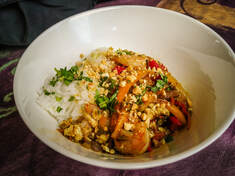 Here are some of our favorite recipes using fresh peppers: -Thai Shrimp Curry: This was one of the first recipes that I curated myself, from a combination of 3 other recipes I had tried from various places. I first served it at a Christmas-time gathering with our extended family last December, and it has been a hit ever since. Pairing: Gunpowder Falls Dunkel  -Veggie Frittata: This easy one-skillet dish has a nice blend of late summer vegetables, topped with Asiago cheese. 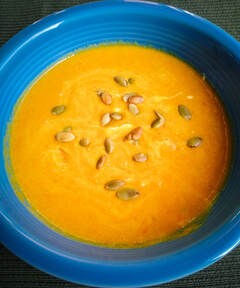 -Pot of Gold Soup: This beautiful bowl is the culmination of a bringing-together of veggie broth, saffron, carrots, and yellow and/or orange peppers. It is just beautiful. Pairing: Allegro Skin Chardonnay 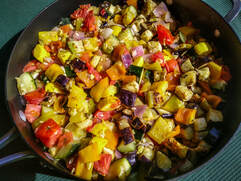 -Ratatouille Nests: This is an amazing way to bring together the bounty of an August garden: eggplant, squashes, peppers, and tomatoes. Serving the ratatouille over a nest of egg pasta is truly inspired. Pairing: Allegro Dry Rosé  -Kicky Fingers: Raw jalapeno peppers give these fingerling potatoes a peppery kick. 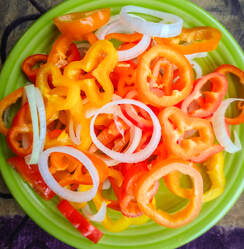 -Pickled (Sweet) Peppers: Honestly, who doesn't want to pack a pint of pickled peppers? This recipe produces sweet pickled peppers which are an amazing accompaniment to sandwiches and salads.  -Homemade Salsa: With 6 (!) kinds of peppers in the fridge, I turned to a friendly online recipe for Freezer Salsa and cooked up a big batch. I like being able to control the heat in the salsa, and added some extra cilantro.  -Many Pepper Relish: You can make this versatile condiment more or less spicy, depending on your blend of peppers. Wonderful with crackers and cream cheese!
0 Comments
Carl lived in Germany for five years as he was growing up. German was basically his first language, and he has a lot of nostalgia for Germany's tastes and traditions. I learned German in college (so that I could understand what his dad was saying during pre-dinner prayers) and had the wonderful fortune to spend a 10-week college term living in Vienna, studying music, literature, and art history. It seems like many lifetimes ago, but Carl and I have been able to visit Germany together three times, most recently in December of 2017, when we took our boys to experience real Christkindlmärkte in Aachen and Köln. Carl and I spent a wonderful and memorable three weeks together in France and Germany in the summer of 1999. He took a vacation from Mount Nittany Winery in State College and we made a trip specifically to learn more about French and German wine regions. In Germany, we split our time between the Mosel and Rhein river regions, where the grapes grow on the steep hillsides around the rivers. We traveled by boat up and down the rivers among the castles and small towns, tasting the wines of the region, which were memorably tart and fresh. It seemed like every town we visited was having either a wine or beer festival. It was a good time. The wines took a bit of getting used to. Particularly in the Mosel region, they were so tart that drinking them was a puckering experience. We tried a few red wines but quickly decided to stick to whites. The red wine of Germany is Spätburgunder: a Pinot Noir which certainly was light compared to the outstanding reds we had just fallen in love with in Burgundy. The German Weißherbst is their light rosé. The cool river climates of Germany are perfect for growing Riesling, but the challenge is often getting the grapes ripe enough to not be so tart. In a really good growing season in Germany, the Riesling will be left to hang as long as possible in the vineyards, and there is a whole classification system for quality, having to do with how far the ripening can go: from Kabinett through Spätlese and Auslese, all of the way to the dessert wines: Beerenauslese and Trockenbeerenauslese. When we came to Allegro in 2001 there was Riesling in the vineyards in The Brogue, but we ultimately found that this isn't the right place for it to grow. We don't have the cool nights needed for Riesling flavor development, like they do in the Finger Lakes region of New York. Carl pulled out our Riesling after the 2016 harvest. These days, we source our Riesling from Johnson Estate Winery in the Lake Erie region of New York.  Last night was one of our favorite theme nights here: To celebrate the visit of our dear friends Margaret and Scott, we pulled out all the stops to enjoy a (socially-distanced outdoor) German feast together. Margaret is a friend of ours from college, and she was a German major who also was part of my wonderful term abroad in Vienna. First, the beverages: We enjoyed some of Scott's homebrew, followed by four Allegro wines: the 2009 Riesling, 2008 Riesling, 2018 Gewürztraminer/Traminette, and (with dessert) the current semi-sweet Riesling. Aged Riesling is an acquired taste, since it tends to pick up flavors both of honey and petroleum (!) with time. Interestingly, I enjoyed the 2008 quite a bit more than the 2009. The wines--particularly the Gewürztraminer/Traminette--all really did pair well with the German-style foods.  Next: the foods! I pounded out some pork schnitzel and paired it with potato dumplings (Kartoffelklöße!) and these other sides: -Skillet Spätzle: Similar to my recipe for Mac 'n Cheese 'n Onions, this is a comforting carb wonder. The fresh Spätzle are lightly sautéed with butter and caramelized onions before being stirred with grated cheeses. Fifteen minutes finishing in the oven make this one happy dish.  -German Red Cabbage (Rotkohl): While it takes a couple of hours to cook, this traditional German side dish brings so much to the table: color, acidity, and a bit of spice (cloves). 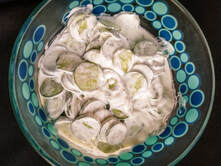 -Cool Cucumber Salad: We really love this creamy summer salad with cucumbers and dill. It's easy to make ahead of time and serve for contrast.  -Refriger-Pickles: So easy and tasty! For dessert I made a full pan of blackberry custard Kuchen, similar to my Raspberry Custard Cakes, paired with the semi-sweet Riesling. Yum. It's amazing how bringing these flavors all together with good friends sitting outside on a summer evening really did take us back to the days of visiting Weinkeller and Heurigen together in Germany and Austria. Wirklich toll!
Prost, Kris Somehow we've made it to the latter part of the summer, even though the days have seemed to run together ever since March. The seasons march on, the grapes are ripening, and we have been inundated by the harvest of another favorite "fruit": fresh tomatoes. While we don't garden ourselves (other than what Carl calls his one-perennial garden of grapes), we still have the pleasure of receiving a bounty of fresh vegetables from others. This meant that, this past week, our fruit bowl was overflowing with at least five different varieties of fresh tomatoes.  This meant that it was time to get creative in the kitchen, not letting one single little tomato go to waste. We have to store up on fresh flavors, remembering the long months down the road when grocery store tomatoes don't hold even a fraction of this flavor. Here are some of my favorite go-to fresh tomato recipes: Caprese Salad Skewers: A great way to start a festive summer feast, easy to make ahead and customize. Wine suggestion: Pinot Grigio.  Fresh Tomato Ricotta Lasagna: Making your own ricotta cheese means adding an extra hour and a half of time to make this entrée, but it's so easy and the payoff is so great that it really makes this dish sing. Wine suggestion: Cadenza Vineyards Chardonnay  Garden Tomato Soup: Roasting large sections of fresh tomatoes is very satisfying and gives this soup a really nice depth of flavor. Wine suggestion: Sauvignon Blanc 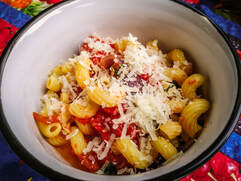 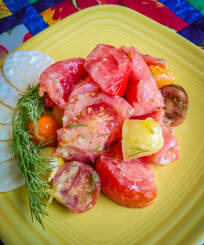 Tangy Tomatoes: This fresh and simple tomato salad gets its zing from a healthy splash of fresh lemon juice and lemon zest, as well as fresh dill. Wine suggestion: Gewürztraminer/Traminette  As members of a robust regional CSA (Lancaster Farm Fresh Cooperative), we've grown used to sometimes bringing home vegetables which we might not even have known existed before. When we get something new--fairytale eggplants? kabocha squash?--I get to accept the challenge of figuring out what it is and how we might best enjoy it. This week, my challenge was a veggie which at first I couldn't even identify, until I looked again at the week's list. It was, of course...pink celery. 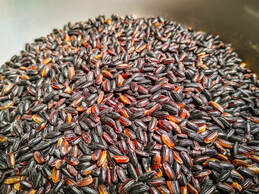 It turns out that pink celery can be used pretty much like regular celery, though it has a stronger flavor. The wheels started turning for me as I thought about what kind of dish might enjoy the addition of this crunchy and colorful newcomer. What came to mind was a black rice salad. Black rice is also colorful, cooking to a deep purple, and its chewy texture, I decided, would be a nice contrast to the little pink curls of celery. I got to work. 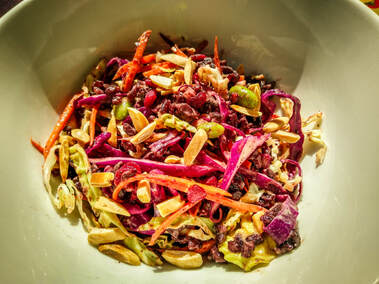 I ran through a mental inventory of other ingredients I have on hand which might also offer textures and colors to complement the rice. I julienned a bright orange carrot, pulled out some blanched edamame left over from another recipe, thinly sliced a bit of green and purple cabbage, remembered that I had some pomegranate arils in the freezer, and toasted some almond slivers. For the dressing, I gathered some of the usual suspects (olive oil and fresh lemon juice), plus miso and tahini and Sriracha, for more flavor. The resulting salad, I can happily report, is a success. There's a great mix of colors and textures and flavors, and it's pretty perfect for a mid-August lunch, with a chilled glass of Sauvignon Blanc. I'm happy to now have formally met the new friend that is pink celery, and I'll look forward to see what's in next week's share. Blue butternut? Crimson cauliflower? I'll let you know. 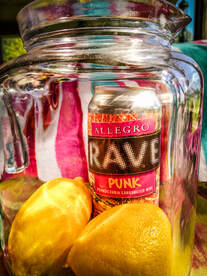 There isn't much that's more refreshing than lemonade. Well, I guess sparkling lemonade. Well, I guess sparkling pink lemonade. Well, I guess spiked sparkling pink lemonade. And an idea was born... I know that necessity is sometimes the mother of invention. So is thirst. And curiosity. Allegro's RAVE wines--sparkling sweet fruity drinks in cans--are quite refreshing on their own. They are easy to chill and share. I just added a twist. 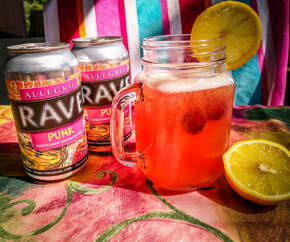 To infuse RAVE Punk (pink Catawba) with lemon, I decided to make a lemon base, with sweetened fresh-squeezed juice--and add it to the glass before carefully pouring in a can of RAVE Punk (to keep the bubbles). Since I don't like to dilute drinks with water, I added grape ice to the drink to keep it cold. Voilà--a spiked sparkling pink Punk lemon-RAVE! Cheers! When I'm hosting friends and family, I definitely like to keep things simple, and I like to plan ahead. I hate rushing around like a madperson before or after people come over; I'd rather have gotten everything ready and anticipated all contingencies ahead of time. As a guest, my favorite get-togethers are also times when the hosts are comfortable and enjoying themselves as much as I am. This was certainly true one evening last year, when I was visiting my friends Gretchen and Mike. They are great hosts, with a deep wine cellar (including a refrigerator drawer just for bubbly wines, when they know I'm on my way) and a knack for delicious snacks, great cheeses, and delightful appetizers. It's with them that I first had my first Pimm's cocktail, my first Tête de Moine cheese. An evening with them is like an evening of ahhhhhhh. On this particular evening, Gretchen shared with us an appetizer which she'd had with her wonderful friend Tan. Tan lives in Las Vegas, and I've had the good fortune of getting to know her and her family from the visits I've made with Gretchen when she's producing trade shows in Las Vegas. A few years ago, Tan made us one of the best pasta meals I've ever had...but I digress. So: radishes. Tan and Gretchen put out a simple array of four ingredients: sliced baguette, butter, very thinly sliced radishes, and sea salt. That's it. To assemble the app, you simply put them together in that order, and enjoy. I spent about half an hour exclaiming over them and trying to figure out why they're so good, but they somehow are. Just so good.
Wine pairing suggestion: Riesling. So cheers to good friends, relaxed hosts, and the sharing of simple pleasures! 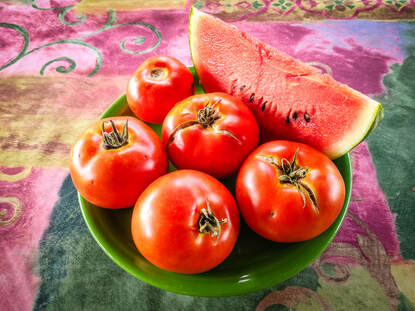 We are not gardeners. Carl likes to say that he can only grown one kind of perennial (winegrapes), and I don't ever claim to have a thumb green enough to grown anything. What we've found, though, is that during the height of the summer growing season, we don't need to know how to grow stuff; we just need to know the people who know how to grow stuff. When the bounty of others spills over their needs, we're the happy recipients of those extra veggies. Sometimes it's tomatoes; other times it's cucumbers and zucchini. (My dad--a successful gardener himself--tells the story of a wheelbarrow that a gardening neighbor put out in their yard. It was full of homegrown zucchini, and there was a sign reading "FREE." The neighbor was puzzled to find, at the end of the afternoon, that there were many more zucchini overflowing the wheelbarrow than there had been at the start of the day. Seems that his neighbors were likewise squash-endowed.)  This year, more than ever, I've done a good job of finding tasty uses for all of the fresh fruits, veggies, and herbs we get from our CSA (Lancaster Farm Fresh Cooperative) and generous friends. This week, we got wonderfully ripe tomatoes from our sales manager Steve. Realizing that we also currently had an overflow of similarly-hued fresh watermelons, I set about to put together a tomato watermelon salad. I browsed through different recipes online and came up with a plan that would combine the two fruits, spiced oil, and feta cheese. (Another good thing these days is how well my "COVID kitchen" stays stocked--I spend quite a lot of time each week making sure our pantry stays stocked, so that visits to the grocery can be placed strategically.) My kitchen these days also has more gadgets and implements than ever before, and I am actually using some things for the very first time. I now have a satisfyingly weighty stone mortar and pestle for grinding spices when I'm making Mexican or Indian meals. I put this to use, grinding together peppercorns, cumin seeds, and coriander seeds, which I infused into olive oil by heating them together on the stove. When the oil cooled, I drizzled it over the tomatoes, seeded watermelon, and feta, and then I sprinkled flaked sea salt over everything. (I have always enjoyed eating watermelon and cantaloupe with a bit of salt sprinkled on, to add another note to the sweet flavors.) It was tasty in a surprising way, and quite refreshing. We paired it successfully with Allegro's food-happy Riesling.
 I really really like limes. Their flavor profile seems somehow more sophisticated than that of other citrus fruits. They smell and taste peppery, zippy, green. I love the way fresh-squeezed lime juice can enliven tacos, Thai food, and drinks. Margaritas. Mojitos. Allegro's Tango wine is a sweet white wine. In its recipe are kaffir lime leaves, orange peel, and mint--it definitely shares a flavor profile with mojitos cocktails, which I make with muddled mint, white rum, lime, and simple syrup. (People often add soda water to their mojitos, as well.) This summer I've been happily supporting PA distillers, buying my vodkas, gins, and rums from Pennsylvania producers. My current favorite white rum is from Maggie's Farm, a Pittsburgh producer. I like the rum, the label, and their commitment to helping animal rescue shelters--all good stuff. Yesterday I decided to try an experiment, with two different drinks. I made my usual mojito using Maggie's Farm white rum, and I made a wine-and-rum cocktail by adding a bit of the rum to a chilled glass of Allegro's Tango. Both of the drinks were quite tasty (of course). Because of the mint factor, traditional mojito cocktails can sometimes be a bit challenging to pair with food, but my "Tangojito" had more subtle mint, making it easy to pair with the Spicy Cheesy Mini Muffins I had made for supper (and also enjoyed for happy hour). I had left some of the Fresno pepper seeds in the muffin recipe this time, so they were quite spicy. The Tangojito actually cooled that heat. So--cheers to PA wine and spirits, to limes, to animal rescues, and to summer's bright flavors!
 Allegro's Celeste wine is made from a combination of peaches and white grapes. It's a nice sweet summer sipper on its own, but I was interested to see how I might pair it with a summer fruit dessert. Since peaches and blueberries are naturally happy companions in other baked goods we've enjoyed, I decided to see how my blueberry coffee cake recipe would taste with a class of chilled Celeste. I'm happy to report that it worked really well. I did realize, though, that I had turned my recipe into something other than a "coffee cake," since it was being enjoyed with wine rather than coffee. So I've renamed it a "Blueberry Happy Cake." Not super-original, but I really do like this recipe, which is easy to make and very enjoyable, thanks in no small part to the blueberries and the Sugar in the Raw which gets sprinkled on after it comes out of the oven. The turbinado sugar gives it a nice little crunch. The 2019 vintage is the first time that Allegro has produced a Dry Rosé wine, and I for one am happy about it. I love this wine style--drinking it takes me back to the time when Carl and I joined Ed Boyce and Sarah O'Herron, owners of Black Ankle Vineyards in Maryland, for a wonderful evening of tapas and dry rosés from Spain. So many amazing tastes, all pairing well with the versatile crisp wine. Dry rosés are basically just light dry red wines. The juice and skins aren't left in contact with each other for very long, so the wine doesn't pick up much color or tannins. Some dry rosés are more fruit-forward; Allegro's 2019 vintage is more crisp and subtle, a really great food accompaniment. At a recent family supper, I made a crustless ("crust-free") mushroom quiche which paired really well with our Dry Rosé. This spring I came across a recipe for a crustless quiche, and I jumped at the chance to try it. As much as I love traditional quiche and pies, I don't share my mom's talent with making pie crusts. Why not simply leave out the crust? I couldn't think of a good reason, and the crustless version turned out really well. Every quiche I've made ever since has been crust-free, and I haven't heard one complaint.  Quiche recipes are endlessly tweakable. For this recipe, I just remember the basic ratios--6 eggs to 1.5 cups of light cream to 2 cups of cheese--and then add whatever veggies, seafood, or spices seem like they would play well together. This week I was in a mushroom mood, so I put together this arrangement of oyster and white mushrooms, fresh thyme, Emmentaler and Fontina cheese, shallots, and nutmeg. It was a hit. The quiche paired nicely with the Dry Rosé, too. The quiche brought out the fruit in the rosé, and the flavors definitely complemented each other. Cheers! -Kris |









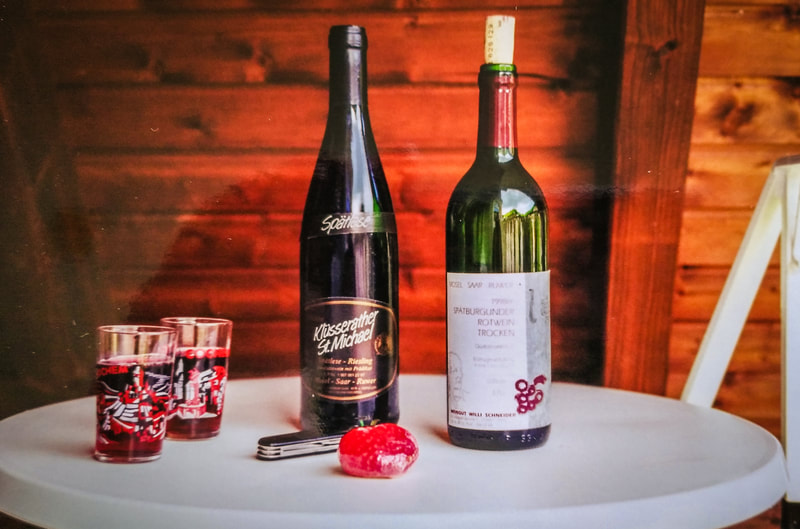
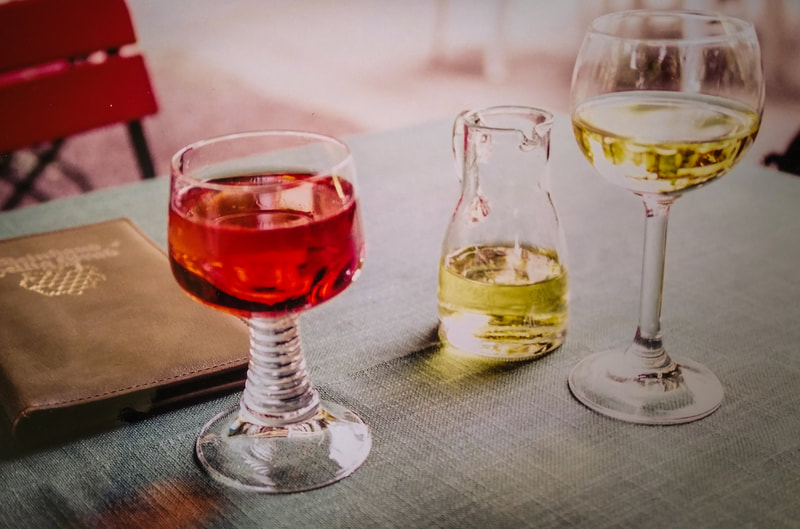
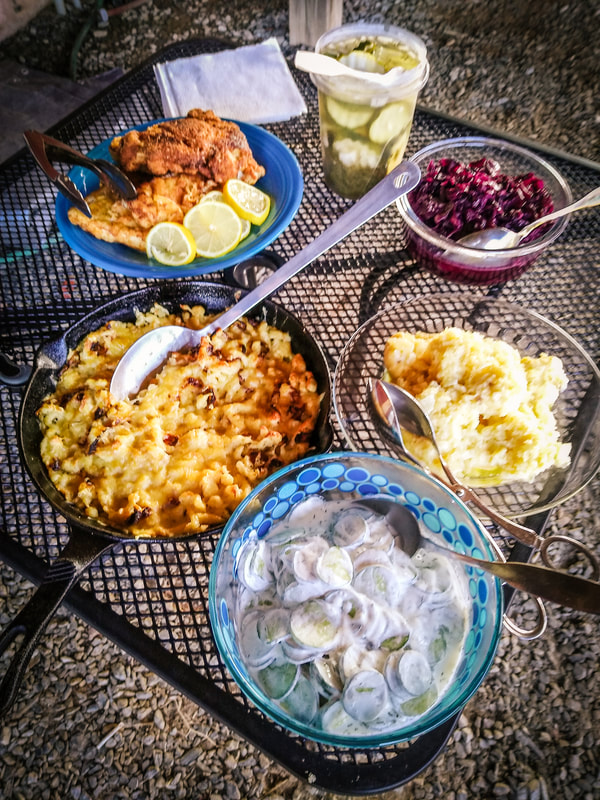
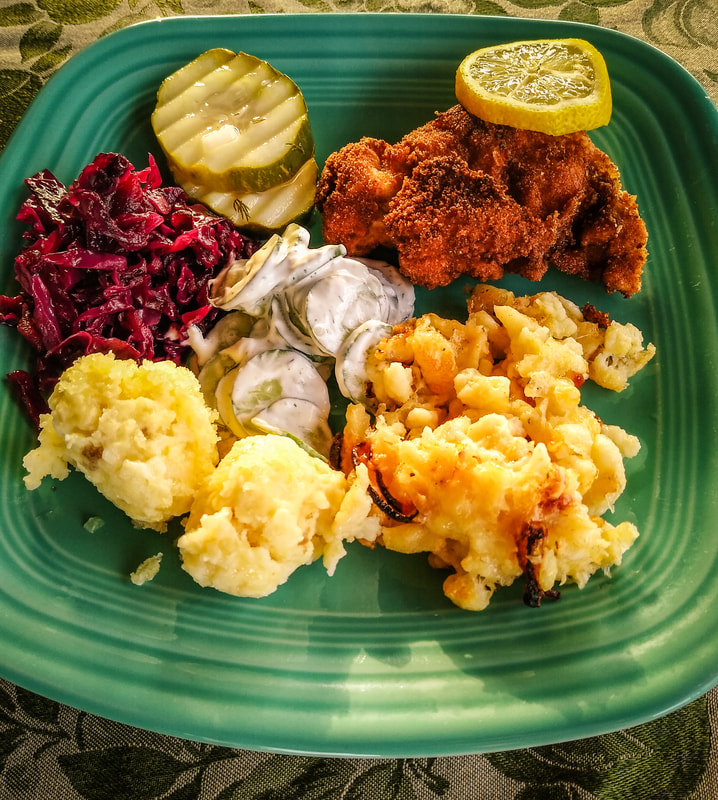
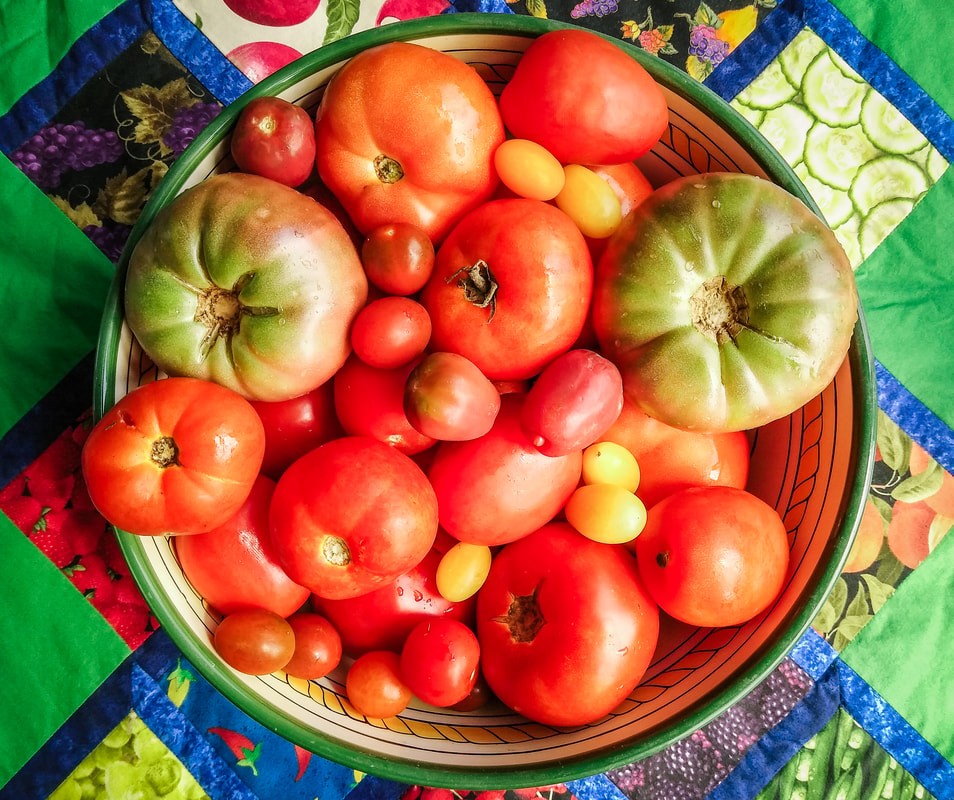


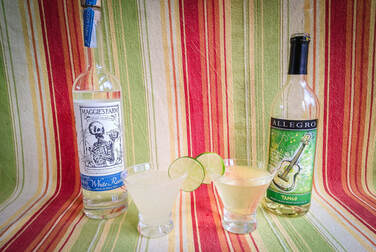
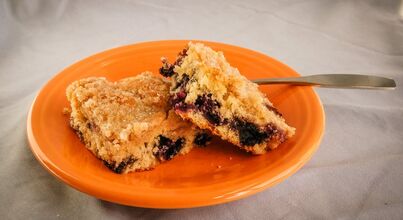

 RSS Feed
RSS Feed